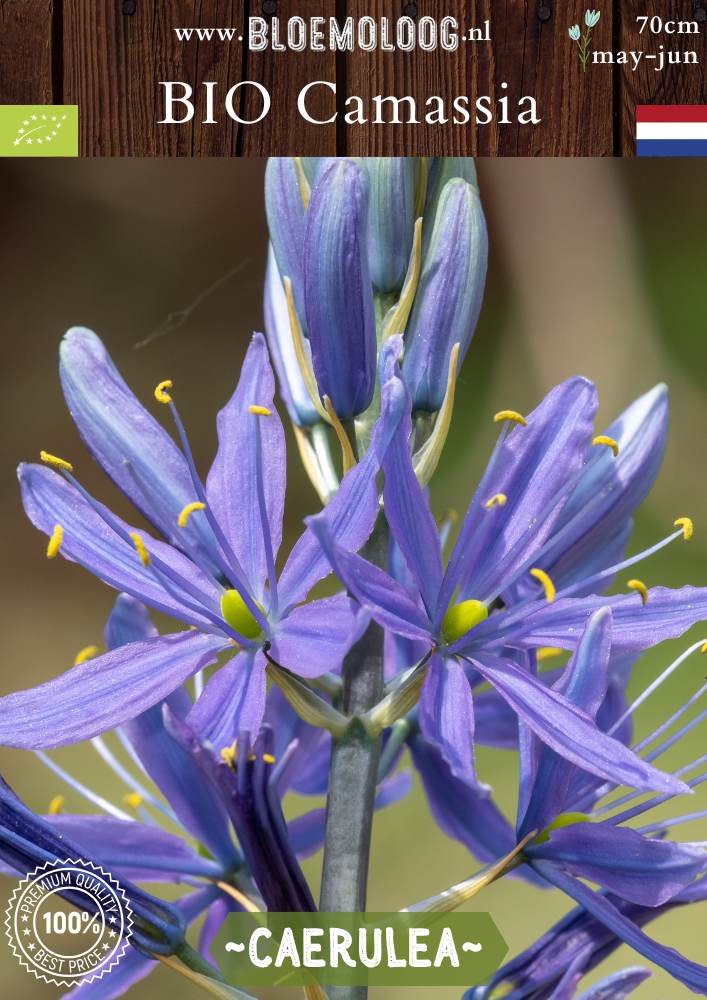Bloemoloog
Organic Camassia leichtlinii 'Caerulea' - Indian hyacinth | 3 pcs.
Organic Camassia leichtlinii 'Caerulea' - Indian hyacinth | 3 pcs.
Estimated Shipping Widget will be displayed here!
Couldn't load pickup availability
Organic camassia bulbs
The Camassia leichtlinii 'Caerulea', also known as the Indian Hyacinth, is a relatively large plant that stands out in the garden. The blue flowers appear in dense clusters atop long, sturdy flower stems about 70 centimeters high. The flowers have a diameter of about 4-6 centimeters and have six petals that together form a star-shaped flower. The plant has long, narrow leaves that grow upright. The leaves are green in color and have a graceful appearance.
This camassia usually blooms in late spring or early summer, usually from May to June.
How, where and when do I plant Camassia flowerbulbs?
The flowerbulbs of a camassia need a cold period. It is best to plant them in the ground from September to January. The planting depth is 2 to 3 times the size of the flowerbulb and the planting distance is also 2 to 3 times the width of the flowerbulb. It prefers well-drained soil that is moderately moist. It does well in a variety of soil types, including clay, loam and sandy soil. It is important to ensure that the soil is not too waterlogged, otherwise the flowerbulbs may rot.
Camassia leichtlinii 'Caerulea' thrives best in a sunny or slightly shaded position. It blooms in partial shade, but will probably produce fewer flowers. Choose a spot in the garden where the plant receives sufficient sunlight for optimal growth and flowering.
Care of the Indian hyacinth
The camassia is an extremely strong bulbous plant that naturalizes well. She does not need any special care. Plant it in a place in the garden where it can grow into a plant with many flower stems for years.
Origin of the Camassia leichtlinii
Camassia leichtlinii is native to North America, primarily the western regions of the United States. It grows naturally in moist meadows and along streams.
Camassia quamash was traditionally used as a food source by indigenous peoples such as the Nez Perce, Blackfoot, and Shoshone. The plant's tubers, which are rich in starch, were harvested, cooked and eaten as part of their diet. We are talking about the camassia quamash here, hence the name Camassia (quamash).
Camassia plants were first discovered and collected by Western botanists during the explorations of European settlers in the 18th and 19th centuries. British botanist David Douglas was one of the first European explorers to bring several camassia species to Europe for botanical study.
In the 19th century, the camassia began to become popular as an ornamental plant in gardens because of its beautiful flowers. Selective breeding resulted in several varieties with improved properties, including the 'Caerulea' variety with its beautiful blue flowers.
Buy Organic Camassia leichtlinii 'Caerulea'
Skal NL-BIO-01 certified: 109459
Packaged per 3 flower bulbs or choose a stacking discount!
Stacking discount: C
Can be ordered from June '25!
EU shipping €8.95 - Free shipping from €100 purchase.
Characteristics
| Flowering time: | May - June |
| Planting time: | From September |
| Planting depth: | 15 cm deep |
| Planting distance: | 15 cm apart |
| Height: | 70 cm high |
| Flower diameter: | 5cm wide |
| Location: | Partial shade, sun |
| Winter hardiness: | Loam, sandy soil - Slightly acidic/neutral |
| Propagation: | Good (naturalizes) |
| Origin: | North America |
| Family: | Asparagaceae (asparagus family) |
| Colour: | Blue |
| Bee-friendly: | Yes |
| Fragrant: | Yes |
| Bulb size: | 14+ |

NL-BIO-01
To share












